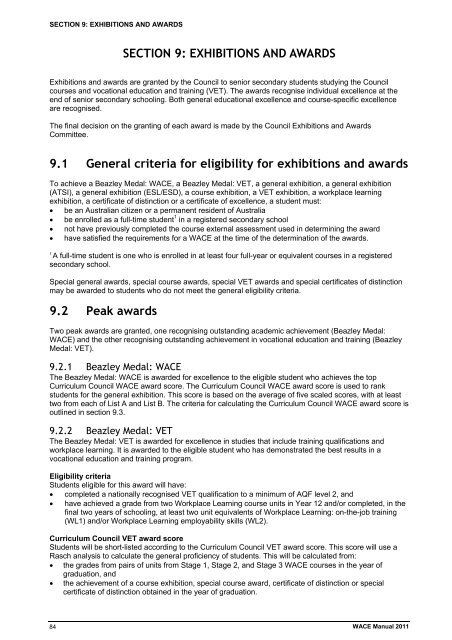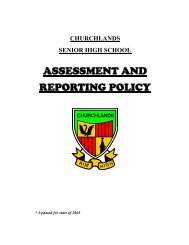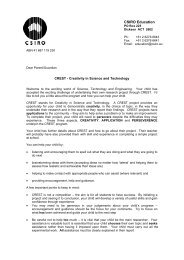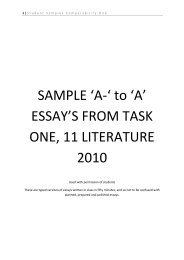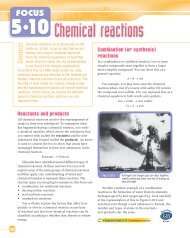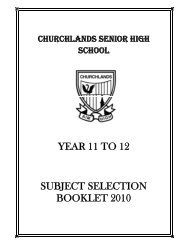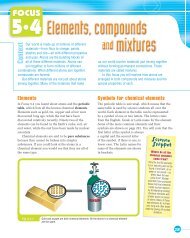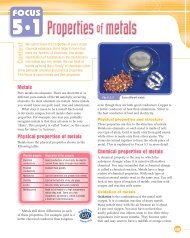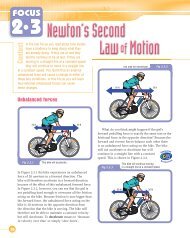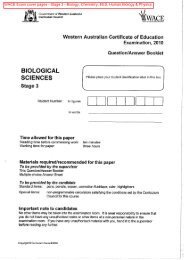SECTION 9: EXHIBITIONS AND AWARDS 9.1 General criteria for ...
SECTION 9: EXHIBITIONS AND AWARDS 9.1 General criteria for ...
SECTION 9: EXHIBITIONS AND AWARDS 9.1 General criteria for ...
You also want an ePaper? Increase the reach of your titles
YUMPU automatically turns print PDFs into web optimized ePapers that Google loves.
<strong>SECTION</strong> 9: <strong>EXHIBITIONS</strong> <strong>AND</strong> <strong>AWARDS</strong><strong>SECTION</strong> 9: <strong>EXHIBITIONS</strong> <strong>AND</strong> <strong>AWARDS</strong>Exhibitions and awards are granted by the Council to senior secondary students studying the Councilcourses and vocational education and training (VET). The awards recognise individual excellence at theend of senior secondary schooling. Both general educational excellence and course-specific excellenceare recognised.The final decision on the granting of each award is made by the Council Exhibitions and AwardsCommittee.<strong>9.1</strong> <strong>General</strong> <strong>criteria</strong> <strong>for</strong> eligibility <strong>for</strong> exhibitions and awardsTo achieve a Beazley Medal: WACE, a Beazley Medal: VET, a general exhibition, a general exhibition(ATSI), a general exhibition (ESL/ESD), a course exhibition, a VET exhibition, a workplace learningexhibition, a certificate of distinction or a certificate of excellence, a student must: be an Australian citizen or a permanent resident of Australia be enrolled as a full-time student 1 in a registered secondary school not have previously completed the course external assessment used in determining the award have satisfied the requirements <strong>for</strong> a WACE at the time of the determination of the awards.1A full-time student is one who is enrolled in at least four full-year or equivalent courses in a registeredsecondary school.Special general awards, special course awards, special VET awards and special certificates of distinctionmay be awarded to students who do not meet the general eligibility <strong>criteria</strong>.9.2 Peak awardsTwo peak awards are granted, one recognising outstanding academic achievement (Beazley Medal:WACE) and the other recognising outstanding achievement in vocational education and training (BeazleyMedal: VET).9.2.1 Beazley Medal: WACEThe Beazley Medal: WACE is awarded <strong>for</strong> excellence to the eligible student who achieves the topCurriculum Council WACE award score. The Curriculum Council WACE award score is used to rankstudents <strong>for</strong> the general exhibition. This score is based on the average of five scaled scores, with at leasttwo from each of List A and List B. The <strong>criteria</strong> <strong>for</strong> calculating the Curriculum Council WACE award score isoutlined in section 9.3.9.2.2 Beazley Medal: VETThe Beazley Medal: VET is awarded <strong>for</strong> excellence in studies that include training qualifications andworkplace learning. It is awarded to the eligible student who has demonstrated the best results in avocational education and training program.Eligibility <strong>criteria</strong>Students eligible <strong>for</strong> this award will have: completed a nationally recognised VET qualification to a minimum of AQF level 2, and have achieved a grade from two Workplace Learning course units in Year 12 and/or completed, in thefinal two years of schooling, at least two unit equivalents of Workplace Learning: on-the-job training(WL1) and/or Workplace Learning employability skills (WL2).Curriculum Council VET award scoreStudents will be short-listed according to the Curriculum Council VET award score. This score will use aRasch analysis to calculate the general proficiency of students. This will be calculated from: the grades from pairs of units from Stage 1, Stage 2, and Stage 3 WACE courses in the year ofgraduation, and the achievement of a course exhibition, special course award, certificate of distinction or specialcertificate of distinction obtained in the year of graduation.84WACE Manual 2011
<strong>SECTION</strong> 9: <strong>EXHIBITIONS</strong> <strong>AND</strong> <strong>AWARDS</strong>Selection <strong>criteria</strong>The exhibitions and awards committee determines the award winner from the shortlist, according to thefollowing <strong>criteria</strong> (listed in priority order): VET award score (which recognises the grades and awards received <strong>for</strong> pairs of units studied in Year12) AQF level of the nationally recognised VET qualificationcoherence of the WACE programachievement of other Curriculum Council awards, <strong>for</strong> example certificate of excellence or awardsachieved in previous year/s.9.3 Awards <strong>for</strong> outstanding achievement<strong>General</strong> exhibitions are awarded to recognise outstanding academic achievement. The awards relate toWACE courses only and do not include VET industry specific courses. The <strong>criteria</strong> <strong>for</strong> the recognition ofoutstanding achievement in VET industry specific courses are defined in sub-section 9.5.9.3.1 <strong>General</strong> exhibitionsForty awards, known as general exhibitions, are awarded to the eligible students who obtain the highestCurriculum Council WACE award scores based on the average of five un-truncated scaled scores,calculated to two decimal places, with at least two from each of List A and List B. The average marksscaling process is used to determined the scaled scores. List A and List B courses used <strong>for</strong> the CurriculumCouncil WACE award score are listed in Table 20 (VET industry specific courses and Workplace Learningincluded in these lists are not used in the calculation of general exhibitions).Appendix 3 lists the course/subject combinations that are not permitted in determining the CurriculumCouncil award score. In cases of such combinations, only the higher of the two scaled scores will count. Inaddition to unacceptable course combinations listed in Appendix 3, no more than two of Mathematics,Mathematics: Specialist, and the <strong>for</strong>mer TEE subjects Applicable Mathematics, Calculus and DiscreteMathematics can be used.At least two units in each course must have been studied and completed during the last two years of seniorsecondary schooling. Where candidates have accumulated scaled scores over two years, the followingrules apply in calculating the Curriculum Council’s award score:Most scaled scores must have been obtained in the final year of senior secondary schooling.Where a student has repeated a course, the first scaled score obtained is used. Scaled scores inrepeated courses will count only once.9.3.2 <strong>General</strong> exhibition (ATSI)One award known as general exhibition (ATSI) may be awarded to the top eligible Aboriginal and TorresStrait Islander student based on the average of five un-truncated scaled scores, calculated to two decimalplaces, with at least two from each of List A and List B (excluding VET industry specific). At least two unitsin each course must have been studied and completed during the last two years of senior secondaryschooling.The course combinations not permitted in calculating the Curriculum Council award score are listed inAppendix 3. Rules regarding the inclusion of scaled scores in repeated subjects and/or courses are listedin the general exhibition <strong>criteria</strong>.To be eligible <strong>for</strong> this award, the student be must an Aboriginal or Torres Strait Islander as defined by theAustralian Bureau of Statistics.In the event that this student wins a general exhibition, he or she will also receive the general exhibition(ASTI).9.3.3 <strong>General</strong> exhibition (ESL/ESD)One award known as general exhibition (ESL/ESD) may be awarded to the top eligible student with anEnglish as a second language (ESL) or English as a second dialect (ESD) background based on theaverage of five un-truncated scaled scores, calculated to two decimal places, with at least two from each ofList A and List B (excluding VET industry specific). At least two units in each course must have beenstudied and completed in the year of the award.WACE Manual 2011 85
<strong>SECTION</strong> 9: <strong>EXHIBITIONS</strong> <strong>AND</strong> <strong>AWARDS</strong>The course combinations not permitted in calculation of the Curriculum Council award score are listed inAppendix 3. Rules regarding the inclusion of scaled scores in courses are listed in the general exhibition<strong>criteria</strong>.To be eligible <strong>for</strong> this award, the student must have studied two units of the English as an AdditionalLanguage/Dialect course while in Year 12 and have met the ESL/ESD background <strong>criteria</strong> used <strong>for</strong>studying this course.In the event that this student wins a general exhibition, he or she will also receive the general exhibition(ESL/ESD).9.3.4 Special general awardA special general award is presented to students not eligible <strong>for</strong> the award of a general exhibition becausethey have not satisfied the general <strong>criteria</strong> <strong>for</strong> eligibility but who have otherwise achieved the requirements<strong>for</strong> the award of a general exhibition and whose Curriculum Council award score is not below the lowestscore <strong>for</strong> a general exhibition.9.4 Awards <strong>for</strong> outstanding achievement in a courseThe awards relate to WACE courses only and do not include VET industry specific courses. The <strong>criteria</strong> <strong>for</strong>the recognition of outstanding achievement in VET industry specific courses are defined in sub-section 9.5.9.4.1 Course exhibitionsA course exhibition may be awarded to the eligible student obtaining the highest combined mark <strong>for</strong> eachWACE course, provided that the mark is equal to or greater than 95. To be eligible <strong>for</strong> a course exhibition,the student must have completed at least two course units in the year of the award being granted. Nocourse exhibition will be available <strong>for</strong> students who have not sat the examination in that course.Only one exhibition is awarded in each course. Typically, the winner will have completed Stage 3 units inYear 12. Where there are large enrolments in Stage 2 and only a few schools with Stage 3 students, theExhibitions and Awards Committee will review the results from both stages.In the event that there is a tie in the combined mark, then the student with the highest raw examinationmark is granted the award.Where the number of candidates who sat the WACE examination in that course was below 100, theExhibition and Awards Committee may decide to award a course exhibition if the achievement is of anexceptionally high standard.Background candidates sitting a language course which includes background and non-backgroundcandidates are not eligible <strong>for</strong> a course exhibition in the respective course.9.4.2 Special course awardsA special course award may be presented to a student not eligible <strong>for</strong> a course exhibition because theyhave not satisfied the general <strong>criteria</strong> <strong>for</strong> eligibility but who have otherwise achieved the requirements <strong>for</strong> acourse exhibition. Only one award will be available in a particular course.Background candidates sitting a language course which includes both background and non-backgroundcandidates are not eligible <strong>for</strong> a special course award in the respective course.9.4.3 Certificates of distinction (WACE courses)Certificates of distinction are awarded to eligible students who are in the top 0.5 per cent of candidates,based on the WACE course score, or the top two candidates (whichever is the greater) in a course wherethere are at least 100 students. The determination is based on the WACE course score.In the case of language courses which have background candidates, certificates of distinction will begranted to the top 0.5 per cent of eligible candidates or to the top two non-background candidates(whichever is greater). Background candidates sitting a language course, which includes background andnon-background candidates, are not eligible <strong>for</strong> a certificate of distinction in the respective course.Where the number of candidates who sat the WACE examination in that course was below 100, theExhibition and Awards Committee may decide to award certificates of distinction if the achievement is of anexceptionally high standard.86WACE Manual 2011
<strong>SECTION</strong> 9: <strong>EXHIBITIONS</strong> <strong>AND</strong> <strong>AWARDS</strong>9.4.4 Special certificate of distinctionA special certificate of distinction is awarded to students not eligible <strong>for</strong> the award of a certificate ofdistinction because they have not satisfied the general <strong>criteria</strong> <strong>for</strong> eligibility but who have otherwiseachieved the requirements <strong>for</strong> the award of a certificate of distinction. It will be awarded only to candidateswithin the top 0.5 per cent of candidates sitting the examination.Background candidates sitting a language course which includes background and non-backgroundcandidates are not eligible <strong>for</strong> a special certificate of distinction in the respective course.9.5 Awards <strong>for</strong> outstanding achievement in VET9.5.1 VET exhibitionsA VET exhibition may be awarded to the eligible student who is the top student in each industry area <strong>for</strong>the award of certificate of distinction (VET). The selection <strong>criteria</strong> and other promotional material <strong>for</strong> thecertificates of distinction (VET) will be posted on the Council website and sent to schools early in Term 2.Only one exhibition is awarded in each VET industry area.9.5.2 Certificates of distinction (VET)Certificates of distinction may be awarded to eligible students who will complete an Australian QualificationFramework VET Certificate II or higher in one of the national industry areas, in their final WACE year. Theunits of competency achieved <strong>for</strong> the certificate may have been undertaken in a VET industry specificcourse, VET stand alone program and/or VET integrated within courses.Table 21: Industry areas in which certificates of distinction may be grantedIndustry areaAutomotiveBusiness ServicesCommunity Services<strong>General</strong> ConstructionIn<strong>for</strong>mation and CommunicationsMusicRural ProductionScreen and MediaSportTourism, Hospitality and EventsVisual Arts, Craft and DesignTraining package codeAUR05BSB07CHC02/CHC08BCG03/CPC08ICA05CUS09RTE03CUF07SIS08SIT07CUV03Where a school has a student who has demonstrated exceptional achievement in a VET industry area thatis not listed above they may nominate that student under the category of “Other”.For a specific industry area, the number of certificates that could be awarded will be: 0.5 per cent of the number of Year 12 students who have completed a Certificate II or higher in theyear of the award in the industry area, or a maximum of two (<strong>for</strong> industry areas that have less than 400 students completing a Certificate II orhigher).Eligibility <strong>criteria</strong>Students eligible <strong>for</strong> this award will have completed in Year 12: a nationally recognised VET qualification to a minimum of AQF level 2*, and at least two units of Workplace Learning from:o on-the-job-training (WL1) and/oro employability skills (WL2) and/oro the workplace learning course (WPL).The Workplace Learning units need to be undertaken in an industry area that is related to the VETqualification.*Students who are working toward completion of a Certificate III or higher (e.g. school-basedapprenticeships) in their final year will be eligible <strong>for</strong> the award. These students will need to havecompleted a substantial number of units of competency within the industry area.WACE Manual 2011 87
<strong>SECTION</strong> 9: <strong>EXHIBITIONS</strong> <strong>AND</strong> <strong>AWARDS</strong>Selection processThe selection process involves three steps:Step 1 Application School nomination – completion of a nomination <strong>for</strong>m endorsed by the principal/VET coordinator andan industry representative. Student statement submitted with nomination – the student prepares a two-page statement about theirinterest and experience in this industry area focusing on the following key areas:o on-the-job and/or off-the-job training experienceso any new developments and/or trends in your workplace or your industryo the skills and knowledge gained through VET and work placementso future career pathways. Résumé portfolio submitted with nomination – the student provides a current résumé (maximum offour pages excluding certificates) and copies of certificates relevant to the industry area such as:o copies of certificates of training achievemento copies of other achievement such as special recognition by the workplace employer or an industryaward or a community award.Step 2 Short-listingA selection panel will be convened <strong>for</strong> each industry area. Panel members will be nominated by schoolsector/systems and industry and approved by the Council. Students will be short-listed <strong>for</strong> an interviewbased upon (listed in priority order): the evidence submitted at time of nomination consistency of the student’s WACE program with the industry area AQF level of the nationally recognised VET qualification.Step 3 InterviewShort-listed students will be interviewed by a selection panel comprising members from schoolssector/systems together with an industry specific member. Interview questions will be developed by thepanel that will enable students to elaborate on their knowledge and experience in the specific industryarea.Final decisionThe selection panel will recommend winners to the Council’s Exhibitions and Awards Committee.9.5.3 Special VET award and certificate of distinctionA special VET award may be presented to a student not eligible <strong>for</strong> the VET exhibition because they havenot satisfied the general <strong>criteria</strong> <strong>for</strong> eligibility but who have otherwise achieved the requirements <strong>for</strong> a VETexhibition. Only one award will be available in a particular industry area.A special certificate of distinction (VET) may be presented to a student not eligible <strong>for</strong> the certificate ofdistinction (VET) because they have not satisfied the general <strong>criteria</strong> <strong>for</strong> eligibility but who have otherwiseachieved the requirements <strong>for</strong> a certificate of distinction (VET). Only one award will be available in aparticular industry area.9.6 Awards <strong>for</strong> outstanding achievement in WorkplaceLearning9.6.1 Workplace learning exhibitionA Workplace learning exhibition may be awarded to the eligible student who is the top student of thoseawarded a certificate of distinction (WPL). The selection <strong>criteria</strong> and other promotional material <strong>for</strong> thecertificates of distinction (WPL) will be posted on the Council website and sent to schools early in Term 2.Only one exhibition is awarded.9.6.2 Certificates of distinction (WPL)Certificates of distinction may be awarded to eligible students who complete two units of the WorkplaceLearning course in their final year. The number of certificates that could be awarded will be: 0.5 per cent of the number of Year 12 students enrolled in a pair of Workplace Learning units at theend of Semester 1, or a maximum of two (whichever is the higher).88WACE Manual 2011
<strong>SECTION</strong> 9: <strong>EXHIBITIONS</strong> <strong>AND</strong> <strong>AWARDS</strong>Eligibility <strong>criteria</strong>Students eligible <strong>for</strong> this award will, in their final year: start and complete a minimum of two units of the Workplace Learning course achieve an A grade in both course units complete the units by the scheduled Curriculum Council interview date.How to applyThe nomination must include the following:1. Application <strong>for</strong>m completed by the student.2. Student statement (maximum two A4 pages). This is a description of the student’sexperience in the workplace over the duration of the two course units completed in Year 12with a focus on the following key areas: the skills and knowledge gained through the work placement in Year 12 specific examples to demonstrate application of the employability skills in a range ofcontexts how the workplace experiences have shaped the student’s career pathway.3. Workplace per<strong>for</strong>mance profile (on the nomination <strong>for</strong>m). The workplace per<strong>for</strong>mance profileis to be completed and signed by the workplace supervisor and workplace coordinator.4. Validation documents. The student must also provide photocopies of the following <strong>for</strong> the twounits completed in Year 12: workplace attendance record signed and verified by the workplace supervisor <strong>for</strong> bothunits employability skill sign-off <strong>for</strong> both units, verified by the workplace supervisor student assessment outline with marks allocated <strong>for</strong> both units all completed and marked assessment tasks <strong>for</strong> both units photocopy of daily task schedules <strong>for</strong> both units.Selection processThe selection process involves three steps:Step 1 – Application a nomination checklist submitted and signed by the Workplace Learning coordinator school nomination – completion of a nomination <strong>for</strong>m endorsed by the principal andWorkplace Learning coordinator student statement (two-page) addressing the three key areas validation documents submitted with nomination.Schools may nominate only one student. N.B. Late applications will not be accepted.Step 2 – Short-listingA selection panel will be convened. Panel members will be nominated by school sector/systems andapproved by the Curriculum Council. Students will be short-listed <strong>for</strong> interview based on the evidencesubmitted at the time of nomination.Step 3 – InterviewShort-listed students will be interviewed by the selection panel. The purpose of the interview is to enablestudents to provide evidence which demonstrates their knowledge, understanding and application to theirworkplace learning.Students will be asked to elaborate on the three key areas <strong>for</strong>warded at the time of nomination and will begiven the opportunity to respond to questions from the panel. These questions will be designed to clarifytheir depth of understanding of their workplace/s.Students will be provided with the key questions to be asked by the selection panel 10 minutes be<strong>for</strong>e theinterview. The interview will be of 15 minutes duration. Students must bring to the interview their originalWorkplace Learning logbooks and original marked tasks <strong>for</strong> both units.Final decisionThe selection panel will recommend winners to the Curriculum Council’s Exhibitions and AwardsCommittee.WACE Manual 2011 89
<strong>SECTION</strong> 9: <strong>EXHIBITIONS</strong> <strong>AND</strong> <strong>AWARDS</strong>9.7 Certificates of excellenceA certificate of excellence is to be awarded to each eligible student who, in their last three consecutiveyears of senior secondary school WACE enrolment, obtains at least 18 ‘A’ grades in course units orequivalents (including a least three two-unit combinations). Up to eight unit equivalents can be fromendorsed programs and/or VET units of competency.Table 22: A grades required <strong>for</strong> a certificate of excellenceUnit equivalents ‘A’ grades required0 181 172 163 154 145 136 127 118 10Completion of a <strong>for</strong>merly accredited D or E code subject is equivalent to two course units. Repeatedcourse units can be used in the determination of this award.At the time of the determination of this award, the student must have satisfied the requirements <strong>for</strong> theWACE.9.8 Certificates and medallionsThe winners of the Beazley Medal: WACE and the Beazley Medal: VET receive a medallion andcheque <strong>for</strong> $2000. In the event of a tie <strong>for</strong> either award, each student in the tie is to be granted amedallion and $2000.Winners of general exhibitions and special general awards receive a medallion, a certificate and aprize.Winners of course exhibitions, VET exhibitions, workplace learning exhibition, special course awardsand special VET awards receive a medallion, certificate and a prize.All other award winners receive a certificate.All certificates are suitable <strong>for</strong> photocopying.9.9 SponsorshipThe aim is that educational and business bodies will provide sponsorship <strong>for</strong> the exhibitions and awards,and that the prizes and presentation ceremony will be self-supporting through sponsorship. The Councilsecretariat seeks sponsorship <strong>for</strong> the exhibitions and awards. Sponsorship packages are available <strong>for</strong>different levels.<strong>9.1</strong>0 Awards ceremonyA presentation ceremony is held in February. The ceremony is inclusive of all Curriculum Councilexhibitions and awards.<strong>9.1</strong>1 Sickness/misadventure claimsA derived examination mark resulting from a sickness/misadventure claim can be included in thedetermination of a Beazley Medal: WACE, a general exhibition, a general exhibition (ATSI), a generalexhibition (ESL/ESD), a special general award, a course exhibition, a special course award, a certificate ofdistinction, or a special certificate of distinction.<strong>9.1</strong>2 Release of in<strong>for</strong>mationThe name and school of award winners is published unless the award winner prefers otherwise. In suchcases, only the name of the school will be published.90WACE Manual 2011


